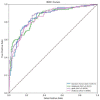An Explainable AI Approach for the Rapid Diagnosis of COVID-19 Using Ensemble Learning Algorithms
- PMID: 35801239
- PMCID: PMC9253566
- DOI: 10.3389/fpubh.2022.874455
An Explainable AI Approach for the Rapid Diagnosis of COVID-19 Using Ensemble Learning Algorithms
Abstract
Background: Artificial intelligence-based disease prediction models have a greater potential to screen COVID-19 patients than conventional methods. However, their application has been restricted because of their underlying black-box nature.
Objective: To addressed this issue, an explainable artificial intelligence (XAI) approach was developed to screen patients for COVID-19.
Methods: A retrospective study consisting of 1,737 participants (759 COVID-19 patients and 978 controls) admitted to San Raphael Hospital (OSR) from February to May 2020 was used to construct a diagnosis model. Finally, 32 key blood test indices from 1,374 participants were used for screening patients for COVID-19. Four ensemble learning algorithms were used: random forest (RF), adaptive boosting (AdaBoost), gradient boosting decision tree (GBDT), and extreme gradient boosting (XGBoost). Feature importance from the perspective of the clinical domain and visualized interpretations were illustrated by using local interpretable model-agnostic explanations (LIME) plots.
Results: The GBDT model [area under the curve (AUC): 86.4%; 95% confidence interval (CI) 0.821-0.907] outperformed the RF model (AUC: 85.7%; 95% CI 0.813-0.902), AdaBoost model (AUC: 85.4%; 95% CI 0.810-0.899), and XGBoost model (AUC: 84.9%; 95% CI 0.803-0.894) in distinguishing patients with COVID-19 from those without. The cumulative feature importance of lactate dehydrogenase, white blood cells, and eosinophil counts was 0.145, 0.130, and 0.128, respectively.
Conclusions: Ensemble machining learning (ML) approaches, mainly GBDT and LIME plots, are efficient for screening patients with COVID-19 and might serve as a potential tool in the auxiliary diagnosis of COVID-19. Patients with higher WBC count, higher LDH level, or higher EOT count, were more likely to have COVID-19.
Keywords: COVID-19; artificial intelligence; disease prediction; ensemble learning; explainable.
Copyright © 2022 Gong, Wang, Zhang, Elahe and Jin.
Conflict of interest statement
The authors declare that the research was conducted in the absence of any commercial or financial relationships that could be construed as a potential conflict of interest.
Figures






Similar articles
-
Explainable Machine Learning to Predict Successful Weaning Among Patients Requiring Prolonged Mechanical Ventilation: A Retrospective Cohort Study in Central Taiwan.Front Med (Lausanne). 2021 Apr 23;8:663739. doi: 10.3389/fmed.2021.663739. eCollection 2021. Front Med (Lausanne). 2021. PMID: 33968967 Free PMC article.
-
Artificial intelligence in clinical care amidst COVID-19 pandemic: A systematic review.Comput Struct Biotechnol J. 2021;19:2833-2850. doi: 10.1016/j.csbj.2021.05.010. Epub 2021 May 7. Comput Struct Biotechnol J. 2021. PMID: 34025952 Free PMC article. Review.
-
Investigating Protective and Risk Factors and Predictive Insights for Aboriginal Perinatal Mental Health: Explainable Artificial Intelligence Approach.J Med Internet Res. 2025 Apr 30;27:e68030. doi: 10.2196/68030. J Med Internet Res. 2025. PMID: 40306634 Free PMC article.
-
Explainable artificial intelligence model for identifying COVID-19 gene biomarkers.Comput Biol Med. 2023 Mar;154:106619. doi: 10.1016/j.compbiomed.2023.106619. Epub 2023 Feb 1. Comput Biol Med. 2023. PMID: 36738712 Free PMC article.
-
Explainability and white box in drug discovery.Chem Biol Drug Des. 2023 Jul;102(1):217-233. doi: 10.1111/cbdd.14262. Epub 2023 Apr 27. Chem Biol Drug Des. 2023. PMID: 37105727 Review.
Cited by
-
Artificial intelligence for diagnosis of mild-moderate COVID-19 using haematological markers.Ann Med. 2023 Dec;55(1):2233541. doi: 10.1080/07853890.2023.2233541. Ann Med. 2023. PMID: 37436038 Free PMC article.
-
Development and application of explainable artificial intelligence using machine learning classification for long-term facial nerve function after vestibular schwannoma surgery.J Neurooncol. 2025 Jan;171(1):165-177. doi: 10.1007/s11060-024-04844-7. Epub 2024 Oct 11. J Neurooncol. 2025. PMID: 39392590 Free PMC article.
-
Graph neural network and multi-data heterogeneous networks for microbe-disease prediction.Front Microbiol. 2022 Dec 22;13:1077111. doi: 10.3389/fmicb.2022.1077111. eCollection 2022. Front Microbiol. 2022. PMID: 36620040 Free PMC article.
-
Explainable Artificial Intelligence in Neuroimaging of Alzheimer's Disease.Diagnostics (Basel). 2025 Mar 4;15(5):612. doi: 10.3390/diagnostics15050612. Diagnostics (Basel). 2025. PMID: 40075859 Free PMC article. Review.
-
Evaluating Vision and Pathology Foundation Models for Computational Pathology: A Comprehensive Benchmark Study.Res Sq [Preprint]. 2025 Jul 4:rs.3.rs-6823810. doi: 10.21203/rs.3.rs-6823810/v1. Res Sq. 2025. PMID: 40630532 Free PMC article. Preprint.
References
Publication types
MeSH terms
LinkOut - more resources
Full Text Sources
Medical
Research Materials

